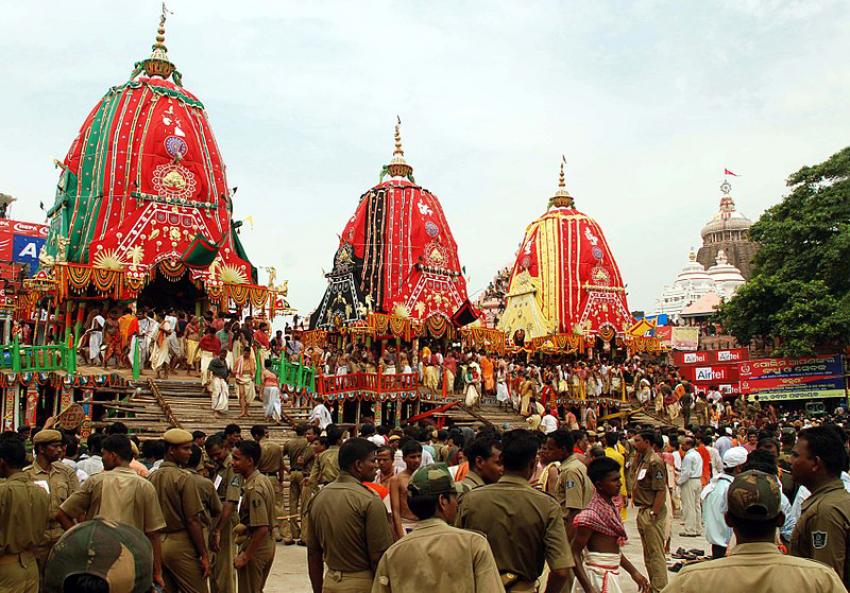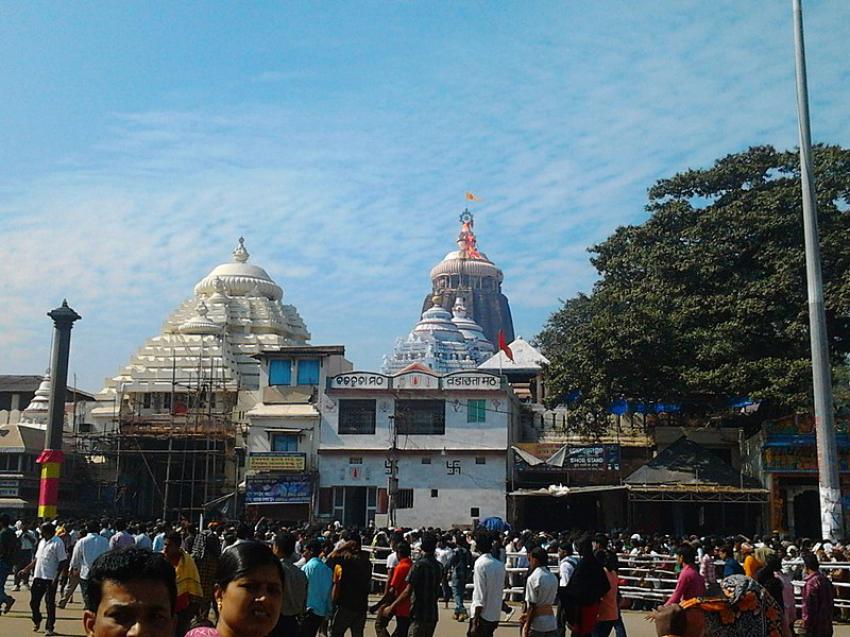NITN | @notintownlive | 19 Jun 2023, 12:46 pm
 Rath Yatra
Rath Yatra
Photo by Krupasindhu Muduli/Creative Commons Attribution-Share Alike 3.0 Unported license
Every year, on the second day of the bright fortnight of the Indian month of Asadh, Lord Jagannath, along with his brother Balabhadra and sister Subhadra, go on a journey, travelling from their 12th century temple in the heart of Puri town (Odisha) to the Gundicha temple, about 3km away, in a procession of three chariots. Known as the Rath Yatra, the entire festival lasts for about 10 days and has many unique rites and rituals. The idols undertake the return journey (bahuda yatra) after a seven day stay in the Gundicha temple.
While the main festival is held in Puri, you will find the same celebration being observed in other places too, especially across Odisha and West Bengal, sometimes with local variations.
This year, Rath Yatra is on June 20.
Puri, Odisha
In Puri, the celebration begins in the main temple square where the wooden chariots – made anew every year – are lined up alongside the Arun Stambh. The chariot (44 feet high) of Lord Balabhadra, Taladhwaja, is draped in red and blue cloth; it runs on14 wheels. The chariot (43 feet high) of Goddess Subhadra, Darpadalan, is draped in red and black cloth; it runs on 12 wheels. The chariot (45 feet high) of Lord Jagannath, Nandighosa, is draped in red and yellow cloth; it runs on 16 wheels.
Devotees and various performing artists gather in the square in front of the chariots. Usually, galleries are erected near the square and along the route (Bada Danda) taken by the chariots.
 Photo by Nitishmohanty67/ Creative Commons Attribution-Share Alike 3.0 Unported
Photo by Nitishmohanty67/ Creative Commons Attribution-Share Alike 3.0 Unported
From early morning, a host of rituals are performed as the three idols are brought from the temple (pahandi) and seated comfortably in their respective chariots. Of the many unique features of the festival, two deserve special mention – one, the ceremony is conducted by a special class of priests called ‘daitapati’, who are believed to be the descendants of a tribal king; two, after the rituals are completed, the king of Puri arrives to sweep the chariot (chhera pahara), an indication that everyone is equal in the eyes of the gods.
Following their return, the idols remain in the chariot. One of the interesting rituals post return is the ‘sunabesh’ when the three idols are decorated with gold ornaments. On the final day, Lord Jagannath has to appease a very angry Goddess Lakshmi (Jagannath being an incarnation of Vishnu) who bars him from entering the temple. After a lot of conversations (conducted by the servitors of both), finally Jagannath is allowed to enter. The crowd disperses with plans to reassemble the following year.
Expect a huge crowd at the venue. The weather can be hot and humid; it may rain occasionally. It is best to follow the instructions of the security personnel on duty and seek their help if you fall sick or meet with an accident.
Baripada, Odisha
This former princely town of Mayurbhanj estate has been observing the Rath Yatra since 1575, according to records, when the town’s Jagannath Temple - built by Shri Baidyanath Bhanj – was inaugurated. It is only here that the chariot of Subhadra is pulled only by women. It is said that the practice was introduced in 1975 to mark the International Women’s Year.
Baripada is about 250km by road from the state capital Bhubaneswar and about 195km from Kolkata in the neighbouring state of West Bengal.
Raj-Ranpur, Odisha
Standing next to the royal palace of Ranpur (Nayagarh) is the sprawling Jagannath Temple complex. According to media reports, the temple was built in 1363 while the chariot festival was introduced in 1754.
Ranpur is about 70km from Bhubaneswar. You may also combine a visit to the Maninaga hills along with Ranpur.
Mahesh, West Bengal
 Photo by Nitishmohanty67/ Creative Commons Attribution-Share Alike 3.0 Unported
Photo by Nitishmohanty67/ Creative Commons Attribution-Share Alike 3.0 Unported
It is said that a close associate of Shri Chaintanya, Kamalakar Pipilai, was entrusted to attend to the idols of Jagannath and his siblings, carved at the behest of a devotee and enshrined in Mahesh in Hooghly district. It was Pipilai who introduced the Rath Yatra. The present chariot, designed like a nine-spired temple, was built in 1885 by the Martin Burn Company.
Mahesh is a mere 25km by road from Kolkata and about 3km from the nearest railway station, Srirampur (Serampore). Hence it draws a huge crowd. Cars have to be parked at a distance from the venue. Because the event usually starts in the second half of the day, you may spend the morning exploring the historical attractions of Srirampur.
Guptipara, West Bengal
Also in Hooghly district, Guptipara is known for its Vaishnav culture and terracotta temples. It is said the chariot festival began in 1745. The chariot was initially built with 13 spires, which was reduced to nine following an accident in 1873. The chariot, which starts from the Brindaban Chandra Temple travels only for a short distance. A fair is organised as part of the festival where you may taste the local delicacy ‘gupo’ Sandesh.
Guptipara is about 90km by road from Kolkata and hence it is best to start early because all roads leading to the temple are closed for vehicles from early morning. Cars have to be parked at a distance from the venue (check with the police personnel on duty for the designated parking lots). Usually, the chariot starts rolling around 2pm. The place lacks a decent washroom facility.
Mahishadal West Bengal
Located in Purba Medinipur district, the rath yatra is held under the aegis of the town’s former royal family. According to reports, the festival was started by Rani Janaki Devin in 1776. However, the chariot has been rebuilt over time.
Mahishadal is about 100km by road from Kolkata and about 20km from the nearest railway station, Haldia. Expect a huge crowd. Usually, the Rath Yatra starts in the second half of the day.
Rajapur, West Bengal
Although records about the origin of the Jagannath temple here are scarce, it is believed the idols were carved about 500 years ago. The temple, which is close to the headquarters of the religious organisation ISKCON, is now looked after by them. On the day of Rath Yatra, the deities ride the chariot to the ISKCON temple complex in Mayapur, about 5km away, in a huge procession.
You may directly travel by road to Rajapur from Kolkata, a distance of around 150km. Or you may travel by train to Krishnanagar and then go to Rajapur by road, a distance of 15km away. Here too the Rath Yatra starts in the second half of the day.
Note: The timings mentioned here for all the chariot festivals is tentative because the actual time depends on the traditional almanac and the organisers. Therefore best to confirm the time before making any plans to visit.
- From Kennedy’s Proposal to 1850s Saloons: The Three Historic D.C. Restaurants Everyone Must Try
- This city has the best bagel in the US, and it’s not New York!
- I escaped to Pachmarhi — what I found in the queen of Satpura left me spellbound
- Air Canada just ranked the Best New Restaurants of 2025 - And the Top Spot isn't who you think
- Rediscovering Arunachal's Monpa Cuisine: One Woman’s Millet Momo Revolution
- Discovering Heritage: A visual journey through Odisha crafts museum Kalabhoomi
- From kebabs to biriyani: Lucknow gets UNESCO honour for its royal cuisine
- Delta takes Spanish flavours to the skies
- Kolkata’s iconic Kathi Roll among world’s top 10 wraps: TasteAtlas
- Yellow Taxis and the Colours of Puja
Air Canada has introduced a new non-stop route connecting Toronto with Rio de Janeiro, with the first flight landing in the Brazilian city on Friday morning.
Air India, India’s leading global airline, and Maldivian, the national airline of the Maldives, have entered a bilateral interline partnership aimed at boosting connectivity between the two countries.
IndiGo, India’s largest airline, is grappling with one of its most severe operational crises in recent years, with widespread flight delays and cancellations disrupting travel across the country for a second consecutive day.





